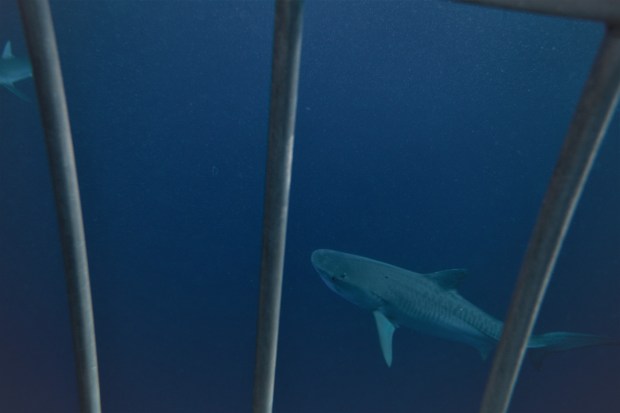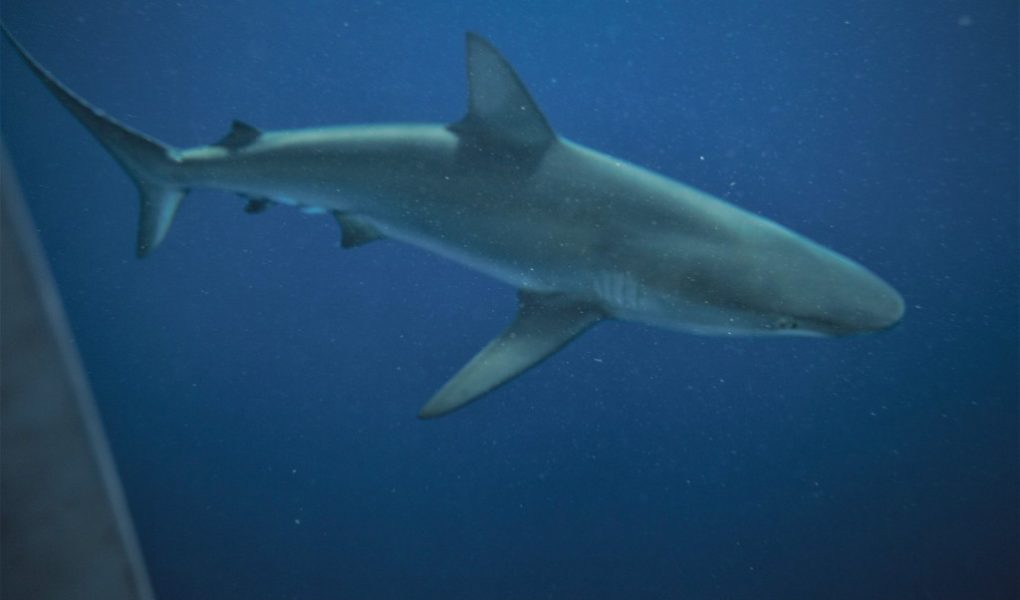The realization that I was entering a reverse fish tank became as clear as the Hawaiian water I was about to dip into off the North Shore of Oahu.
I nervously made my way down the ladder into the small cage floating in 600-foot-deep water and peered through plexiglass as sharks swam in for a closer look at the curious humans marveling at them from within the water-filled box.
My heart raced as several sharks sauntered just feet away, my hands clutching the metal bars tight as adrenaline filled my body. I tried to keep my dangling legs inside the bars, just in case my toes looked like a tasty snack.
As a surfer who spends hours each week sitting on a board waiting for waves out in the ocean, I know sharks come with the territory. The sea is their home, after all.
While curious about them, I’ve never yearned to get close up to a shark. Frankly, I’m pretty certain that if I saw a fin pop out of the ocean’s surface, I’d surely do what experts say not to and flail around frantically to get to shore.
As a beach reporter, I’ve done my share of shark stories. When juvenile great whites a decade ago started showing up in big numbers along Southern California’s coast, I’d talk to experts about their population numbers as the species rebounded.
I’ve also written about nearly every shark-bite victim off Southern California’s coast in the past two decades, from deadly attacks to near-fatal injuries that left physical and emotional scars. While rare, those bites and stories are seared into my memory.
But we’ve also learned much about the mysterious species in recent years, especially with drone technology that captures shark behavior from above. The big takeaway as aerial footage shows sharks swimming near unsuspecting surfers — they really couldn’t care less about humans.
With each story written, my intrigue grew. I had yet to see a shark in the wild.
So while perusing online for a fun activity to do during a surf trip visiting a friend on Oahu, a deal for “Shark Cage Diving” caught my attention.
“What do you think?” I asked my friend Tom Cozad.
“Are you crazy?” he replied.
I’m pretty sure he knew the answer to that question.
So after some back and forth questioning of our sanity, we booked the boat trip out of the Haleiwa Harbor the following morning.
Upon arriving at the Hawaii Shark Encounters boat dock, we were greeted by boat captains Eric Peruzzi and Chris D’Amico, prepping the small vessel for the six passengers signed up for the excursion.
During the 30-minute boat ride to the cage, Peruzzi held an eco-tour educational session about Hawaii’s sharks and conservation efforts to protect them.
The sharks are drawn to the area because for years, fishermen have tossed scraps overboard. So now when sharks hear boat motors, they’re lured to see if there’s a treat.
“Over time, the sharks learned that if they follow the fishermen around, they get easy snacks,” Peruzzi explained.
The sharks don’t eat healthy animals, they go for the sick and diseased, injured, weak or dead, he explained.
“They are our ocean’s filters, they are very important for our oceans and we’re very lucky we still get to go out and do this,” he said. “Because over the last 60 years, we’ve lost about 80-90 % of our sharks around the world from commercial fishing, one of the major factors, and the shark finning industry.”
Shark cage diving has been in the news recently as Guadalupe Island recently banned great white shark cage tourism tours, with Mexico officials arguing the human presence alters the animals’ behaviors and feeding. Others, however, argue shark tourism keeps a watchful eye on the species threatened by shark-fin trade and allows researchers to learn about the species.
Hawaii Shark Encounters was the first to offer tours off the North Shore in 2004. In Hawaii, all sharks are protected and it is illegal to knowingly capture, entangle or kill any shark with a new law passed in 2022, Peruzzi explained, making it the only shark sanctuary in the United States.
“What you’re going to see today is what Shark Week won’t show you,” he said. “You’re going to see what sharks are really like.”
The sharks typically spotted during the tour are Galapagos sharks, discovered off Galapagos Island in 1905, but resident sharks of Hawaii, Peruzzi explained. Males can get up to 10 feet, females in the 12-foot range.
There’s the occasional tiger shark sighting, though they usually show up in warmer summer months, he said.
“We haven’t seen a tiger in a couple months,” he said during our winter-time tour.
Even before getting to the cage site, shark fins started slicing through the ocean’s surface, prompting us to jump with excitement from our seats for a closer look off the side of the boat.
Just as we pulled up to the cage, windy conditions that made for a rough ride proved too much for one of the passengers. She leaned over the side and threw up, right into the cage.
“Maybe the chum will help lure the sharks,” I couldn’t help but awkwardly joke.
After the vomit dissipated, we hoped, we grabbed snorkel gear and gingerly made our way down the ladder to enter the cage, two people to each side.
Before Tom and I had even entered the water, one of the shark divers popped his head up and yelled “tiger shark!”
No. Way.

I was cool with the mellow Galapagos sharks, but the infamous tiger shark is known for its aggressive, and sometimes deadly, nature. My toes instantly curled with fear.
“It was definitely a tiger,” Peruzzi confirmed, after seeing the 13-foot shark with the distinct markings cruise by the boat. “This time of year, they do all their hunting in shallow water. … She happened to come out here.”
When I dipped into the water, my first sight through the clear plexiglass was several sleek, blue Galapagos curiously cruising by the humans in the cage, at times just a few feet away.
The sight wasn’t terrifying as I imagined, in fact quite mesmerizing, almost like an underwater meditation watching how rhythmically the sharks swam.
Then, I saw it. I tugged on Tom’s shirt and pointed down frantically — a girthier shark, with its trademark stripes decorating the top of its body. The tiger shark was right under our dangling legs. Like the other sharks, it was docile, simply swimming by with ease.
The tiger shark swam right in front of us as we stared in awe and it seemed the Galapagos sharks also took notice. As Peruzzi explained earlier, when the tiger sharks show up, other sharks seem to get out of Dodge.
“Not that they are afraid of being attacked, it’s just a respect thing,” he said. “You’re bigger, you swim here.”
In all, the cage dive lasted about 20 minutes and we all left feeling exhilarated, knowing we were eye-to-eye with one of the world’s most mysterious and majestic creatures, buzzing about the tiger shark’s unexpected and awesome appearance.
During the drive back to the dock, Peruzzi gave tips on how to do our part to help sharks thrive, including eating fish from local fishermen rather than commercial operations that may inadvertently kill sharks in bycatch.
Another thing — don’t buy white shark tooth necklaces, he urged.
“White shark teeth mean the shark was killed to get them,” he said. “So avoid that.”
Seeing the sharks up close, I have a newfound respect and more ease about sharing the sea with sharks.
Now that I’ve come face-to-face with sharks, maybe if I see a fin pop up while out surfing my first reaction won’t be panic and fear.
Maybe.
If you go
Hawaii Shark Encounters charges $120 for adults (13 and older) and $90 for children 12 and under for a two-hour cruise. A private charter for up to 10 people is $1,350. Information: hawaiisharkencounters.com
𝗖𝗿𝗲𝗱𝗶𝘁𝘀, 𝗖𝗼𝗽𝘆𝗿𝗶𝗴𝗵𝘁 & 𝗖𝗼𝘂𝗿𝘁𝗲𝘀𝘆: www.mercurynews.com
𝗙𝗼𝗿 𝗮𝗻𝘆 𝗰𝗼𝗺𝗽𝗹𝗮𝗶𝗻𝘁𝘀 𝗿𝗲𝗴𝗮𝗿𝗱𝗶𝗻𝗴 𝗗𝗠𝗖𝗔,
𝗣𝗹𝗲𝗮𝘀𝗲 𝘀𝗲𝗻𝗱 𝘂𝘀 𝗮𝗻 𝗲𝗺𝗮𝗶𝗹 𝗮𝘁 dmca@enspirers.com














